Milk glass is an antique type of glass used to make a wide range of items and can be blown, or pressed to fit your needs. Originating in the 16th century, items made of milk glass have become increasingly popular among antique collectors and some particular types are worth a lot of money.
The textures, colors, markings, and transparency of milk glass can distinguish the age of the glass. The branding and type of piece can determine whether the milk glass is an authentic antique. Paying attention to the details will distinguish the value of the milk glass.
Milk glass is a very beautiful material for antique glass pieces to be made out of, and there are quite a few different styles of milk glass to be aware of. Keep reading to learn more about distinguishing between the different types of milk glass.
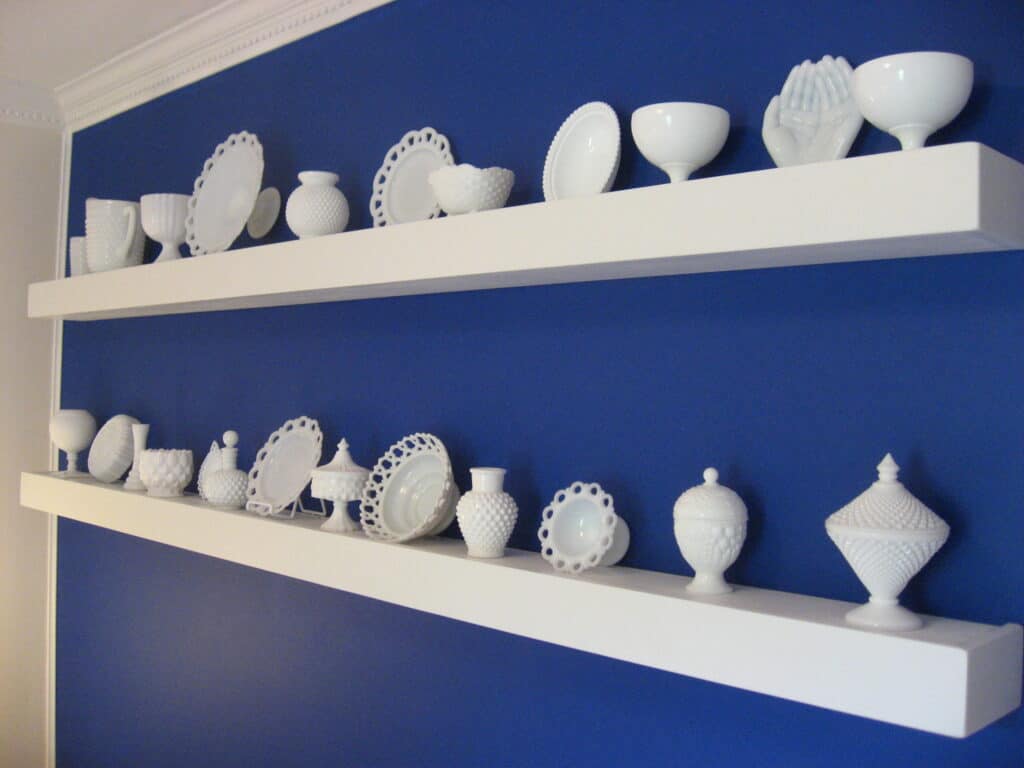
Milk Glass: The Basics
Before we talk about how to determine the different ages, brands, and types of milk glass, it is important to know what milk glass is and what makes it different from regular glass. Milk glass is not a receptacle for holding milk, but rather it refers to the type of glass that various antique glass pieces are made out of.
Milk glass is an opaque glass that can be blown or pressed into whatever shape is desired. Milk glass is typically white, but it comes in a variety of colors as well, like blue, pink, black, yellow, and brown.
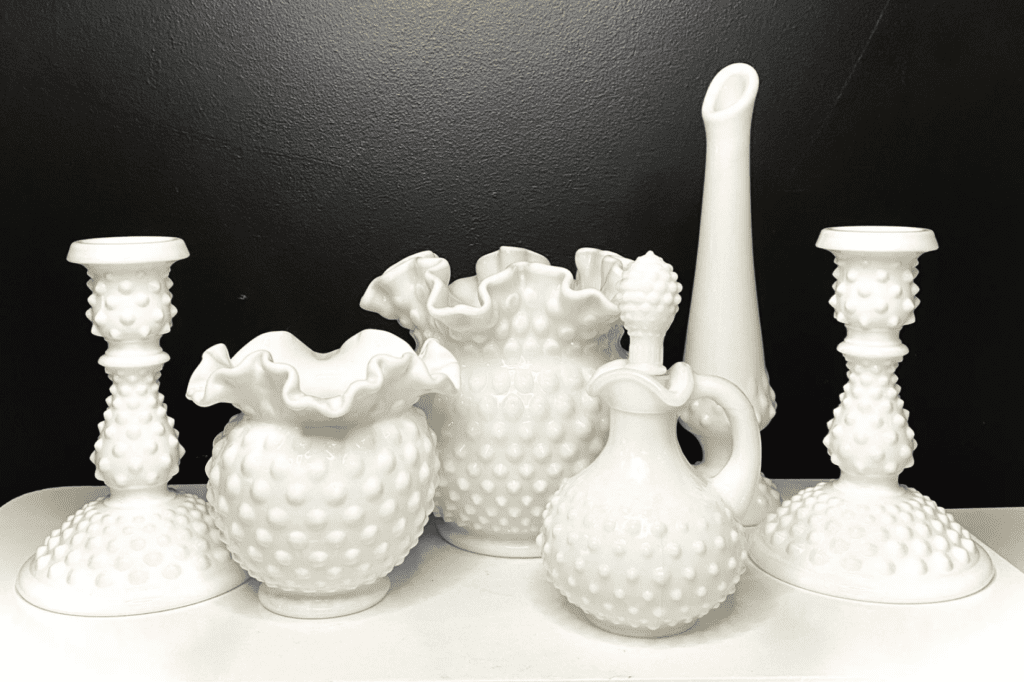
Milk glass was first commonly used in the 16th century in Venice and was known as “opal glass. It quickly became a competitor to porcelain as it was easier to work with and cheaper to manufacture.
Styles of milk glass changed over the years from delicate and dainty in the 1870s, to more sturdy and solid in the 1930s. Milk glass was used to make vases, dresser trinkets, cake stands, and covered dishes as well as sets of teacups and dessert dishes. It has also been used in architectural designs. See also: When Was Milk Glass Popular
Milk Glass vs White Glass
Many people wonder if milk glass is the same as white glass, but it is not. Milk glass is only slightly opaque while white glass is fully opaque. To tell if the glass is authentic milk glass, you can hold it up to a light and look for the small rainbow colors at the edges of the glass.

Types of Milk Glass
Milk glass is already a specific type of glass, but there are still a lot of different types of milk glass out there. Some of these many types and styles are French milk glass, Victorian milk glass, and Hobnail milk glass. Each style is different and has its particular features.
French Milk Glass
French milk glass is a pretty standard style of milk glass. It was made in France from 1800 to about the 1890s and became popular in the 1850s and 60’s around the time of the reign of Napoleon III. French milk glass, like other kinds of milk glass, is opaque, but it was rarely ever white. French milk glass is only ever found in colors.
French milk glass differs from other kinds of milk glass by being very simplistic. There are a lot of milk glass pieces in other styles that have detailing or designs on them, but French milk glass is very simple and plain. It is smooth over the larger surfaces and the overall design of each piece is simplistic.
Victorian Milk Glass
Victorian milk glass is quite different from French milk glass in several ways. Victorian milk glass is where the iconic white color became popular. Victorian era milk glass is actually where the term “milk glass” came from.
It looked exactly like porcelain and became very popular before dying out during the Great Depression. It was later re-popularized in the 1950s and 1960s by some more popular and well-known brands.
Victorian milk glass pieces are characterized by a lot more detail than French milk glass has. Details like lace edges to dishes, surfaces textured with pyramid shapes, grape and leaf designs, and even designing pieces to look like owls and other animals. The animal designs featured incredible attention to detail with feathers, fur, and feet. Victorian milk glass, like many Victorian things, was elaborate and had a lot of detail.
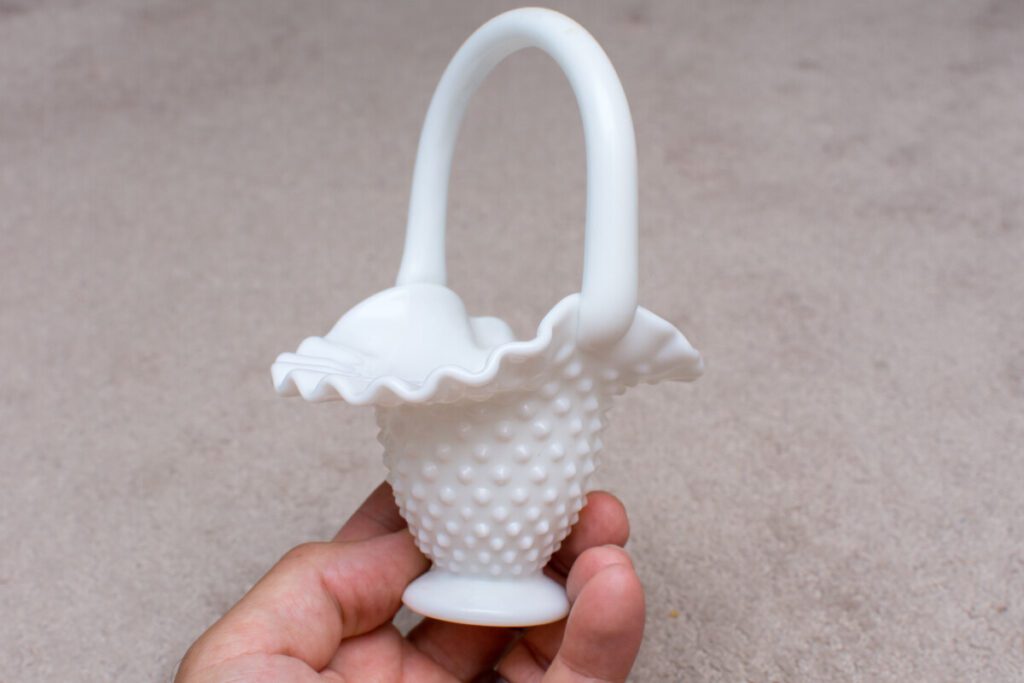
Hobnail milk glass is less of a specific era’s style of milk glass, but rather it is a style and kind of detailing found on milk glass. This is a more modern style of popular milk glass and it began to be commonly used in 1950 by Fenton. It continued to be a huge part of that brand’s style. It was used in many Victorian pieces as well.
Hobnail milk glass is a pattern of raised bumps on the surface of a piece. This is sometimes called “dewdrop” glass. The Hobnail pattern was often used on the bottom of boot soles. Hobnail milk glass is made by blowing the glass into a mold with this pattern in it. The raised texture and consistency make for a beautifully detailed surface with interest instead of just having a smooth surface.
Distinguishing the Age of Milk Glass
Now that you know about some of the common types of milk glass we can talk about how to distinguish between different ages of milk glass. Milk glass has been around for centuries, and the styles differ a lot over the different decades. One way you can differentiate between different types of milk glass is by learning how to tell what period it is likely from.
Style
Milk glass went through a transformation over the decades. The stages of milk glass are roughly: simple colored glass pieces, textured pieces, elaborate white pieces, detailed colored pieces, simpler white pieces, and very textured white and colored pieces.
Based on these general descriptions, you can get a general idea of how old a piece of milk glass might be. If you have a very simple colored piece, it is much older than a hobnail textured piece of milk glass.
Brand
Another way to get a general idea of the age of a piece of milk glass is by looking at the branding on it. Different brands were making milk glass in different eras. An early Fenton piece, which started in about 1905, will be older than an Anchor Hocking piece, which started in 1939.
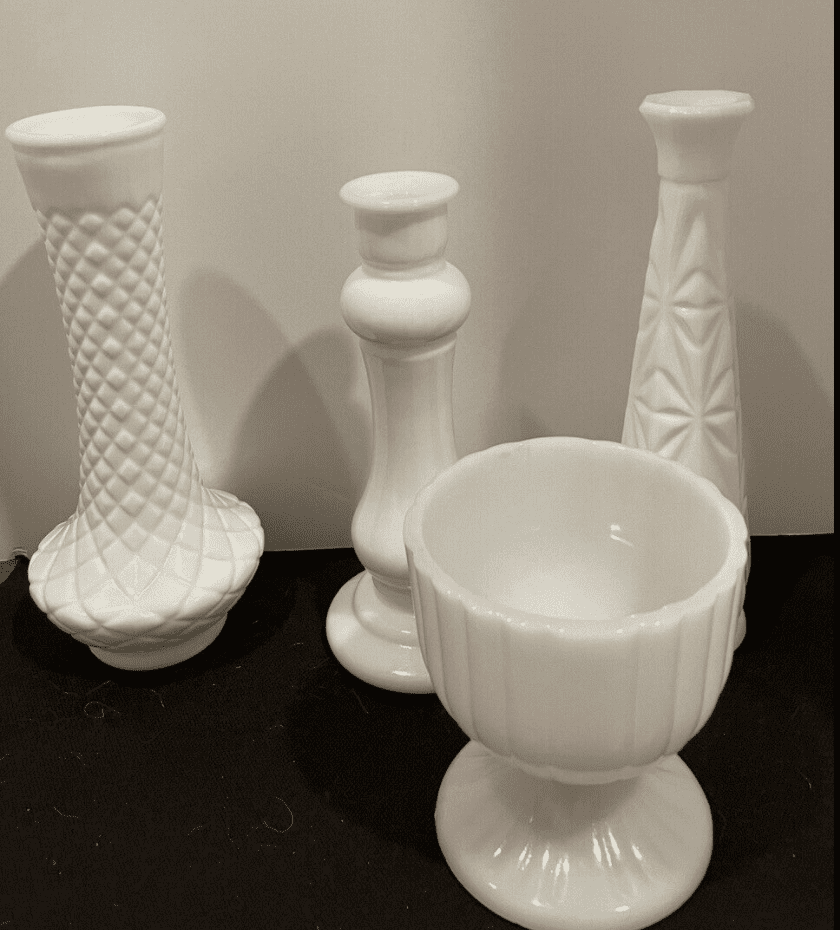
Distinguishing the Brand of Milk Glass
Styles of milk glass and age are just two great ways of distinguishing different pieces of milk glass from each other. You can also distinguish milk glass by its brand.
There are several very popular American milk glass brands to be aware of, like Fenton, Anchor Hocking, and Westmoreland. Each brand has its different traits and common characteristics that they like to follow.
Fenton
Fenton is one of the biggest, if not the biggest, American brand of milk glass out there. They have been manufacturing glass since 1905 and was one of the biggest glass manufacturing brands for over 100 years. They continued to thrive and grow and even when most glass companies were going out of business during the 1940s. Now, Fenton is one of the most well-known milk glass brands among antique collectors.
Fenton milk glass is characterized mainly by hobnails, ruffles, and crests on their pieces. Fenton is the brand that popularized white hobnail milk glass. This style from Fenton was so popular that it became a sure seller for the company for many years. They also took inspiration from more Victorian pieces when they made ruffled edges a huge part of their designs.
Finally, Fenton’s oval crests were a huge part of the designs of their pieces. The crests often had ruffled edges to match the edges of the dish as well.

There are several ways to identify Fenton milk glass. One obvious way is by finding an oval Fenton crest stamped in the glass or by finding a Fenton sticker on the bottom. Another way is by noticing that there is not a pontil mark.
During manufacturing, glass is often left with pontil marks where they were on a stick, but Fenton glass does not have these because they manufacture their glass differently. Also, if the glass piece has bumps of bubbles in it, it is very unlikely that it is a Fenton piece. Fenton is too high quality for pieces with bumps to be sold under the brand.
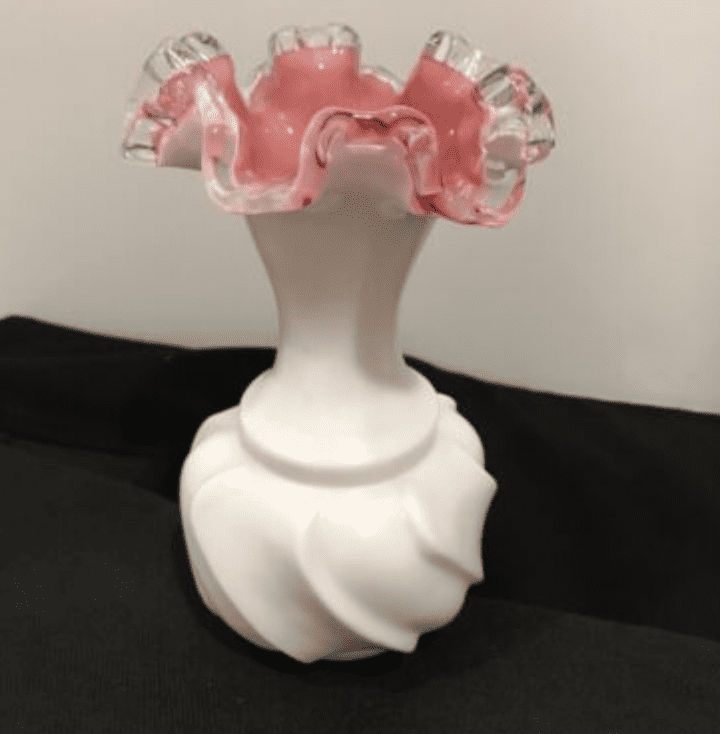
Anchor Hocking
Another well-known brand for milk glass is Anchor Hocking which was also founded in 1905, though they did not manufacture milk glass until much later, around 1939. This brand has several sub-brands of glassware connected to them because of how big they are. Fire King is their sub-brand for milk glass.
Fire King makes milk glass that is similar to Pyrex. Each piece is made from low expansion glass which helps to make it oven safe.
In its early days, Fire King products were given away for free at gas stations and in bags of flour because they were not picking up very much business. Fire King milk glass comes in a large variety of colors and different shades of those colors. Fire King is a more modern brand and makes bowls, casserole dishes, cups, plates, serving platters, and more.
Fire King glass is characterized by much simpler molds and styles than Fenton. They are not as high-end either, though they are very well known. The purpose of milk glass from Fire King is to create cheap pieces for everyday use. The exciting part of their designs comes from the variety of colors that they are in.
Westmoreland
The final glass brand that we will talk about, though not the least important, is Westmoreland glass. Westmoreland is another American glass company and was founded in 1889. This is the oldest company out of the three! Unlike Anchor Hocking and Fire King glass, Westmoreland makes much more milk glass than regular glass. 90% of their glass production from 1920 to 1950 was milk glass.
Westmoreland milk glass pieces are very high quality and have a high amount of neatly crafted detail. They made and used patterns like old quilt, paneled and beaded grape, colonial, lace edges, beaded edges, several kinds of hobnail designs, shells, jewels, and many more. Westmoreland glass has quite a Victorian look to it and maintains that decorative style. While Westmoreland and Fenton both feature glass with a lot of detail, Westmoreland uses colored milk glass much more often while Fenton usually sticks to white milk glass.
When it comes to recognizing Westmoreland milk glass pieces, there are several marks that you will see on pieces from this brand. One mark is a W within a keystone, used from 1910-1929. Another mark is a WG stacked mark used in the late 1940s. The final common mark is the word “Westmoreland” in a circle used around 1982.
Determining Milk Glass Value
Now that you know many of the differences in styles, ages, and brands of milk glass, you can start to get a better idea of how to tell the general value of a milk glass piece. In general, if milk glass is very old, it will be worth a lot more than just any old piece made 10 years ago. However, with certain styles that were very popular when first manufactured, more modern pieces can fetch a pretty penny as well.
When it comes to newer milk glass, the ones that will sell for quite a bit are usually the ones with intricate details, or ones from well-known, high-end brands. A Fenton piece from nearly any year will sell for much more than a Fire King piece.
The final factor in how expensive a milk glass piece goes for is the style. More detailed and intricate styles sell for a lot more. These pieces were made with extra care and take a higher skill level to craft, so they sell for more. If you have an old, intricately designed milk glass piece from a popular brand, it just might be worth a lot of money in the antique world.
Check out our full article on how to determine the value of your milk glass for more information.

